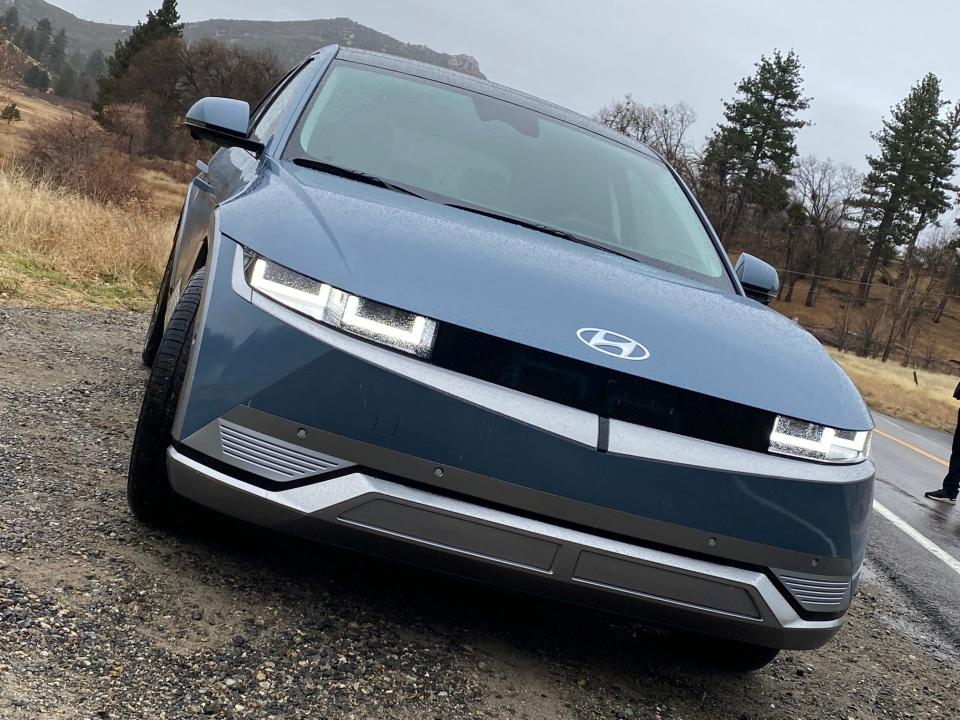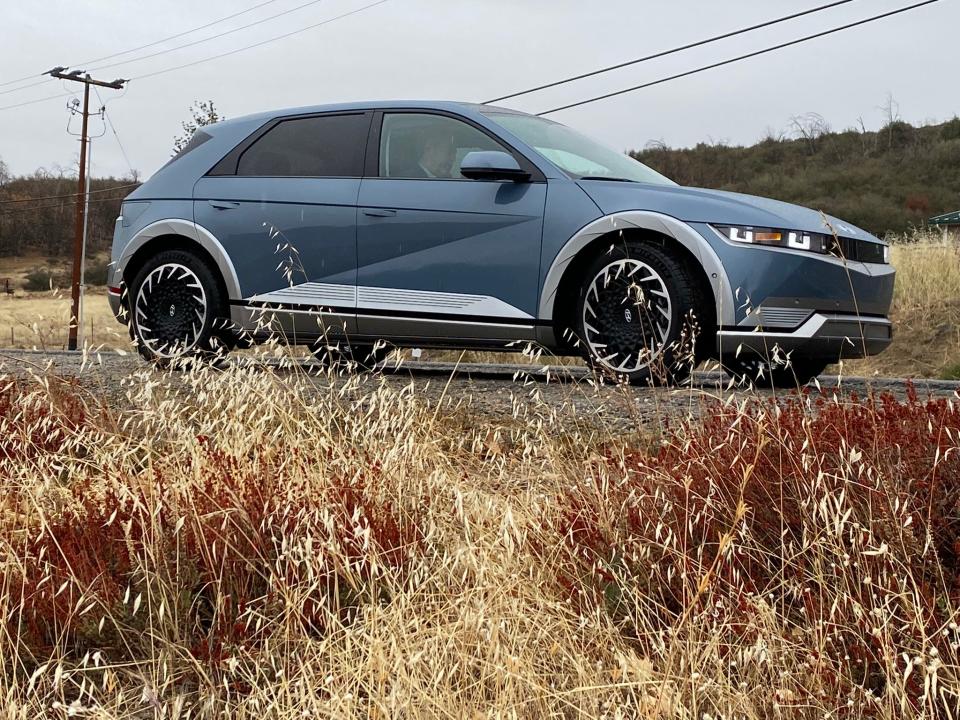2022 Ioniq 5: Hyundai EV offers fast-charge capabilities and competitive prices

Every day, it gets harder to deny electric vehicles are the imminent next great advance in transportation.
Not because governments will mandate them. But because they’re better than what we drive today. We’re drawing ever closer to the moments most buyers demand EVs, then can’t figure out how they got along without them.
The 2022 Hyundai Ioniq 5, a low-slung compact SUV that goes on sale shortly, is the latest EV to make drivers an offer many won’t be able to refuse.
The first vehicle to use the South Korean automaker’s global EV platform, the Ioniq 5 combines competitive prices with a fast level of charging so far only seen in luxury EVs costing many thousands of dollars more.
The ability to recharge batteries quickly is among the great remaining challenges to widespread adoption of EVs.
What is it?
The Ioniq 5 is the first vehicle to use a new architecture Hyundai-Kia developed to underpin its upcoming EVs.
It’s a compact SUV, but exceptionally roomy. Despite being just 0.2 inch longer than the Tucson, Hyundai’s conventionally powered compact SUV, the Ioniq 5 has a wheelbase nearly 10 inches longer, topping even the brand’s seven-seat Palisade SUV for longest in the brand’s U.S. lineup.
► What's in Biden's EV strategy?: 500,000 new charging stations and more
► 'They're not well lit, empty': Some public EV charging stations have drivers concerned for their safety

The Ioniq 5 is 13.6 inches shorter than the hulking Palisade, but takes advantage of its long wheelbase – and a flat floor; no tunnel for drive shaft of transmission in an EV with front and rear motors – to create a roomy passenger compartment and cargo space.
The Ioniq 5 seats five. It’s available with a single motor on the rear axle or one on each axle for all-wheel drive.
The base model has 168 hp and a 220-mile range on a full charge. One step up is a 225-horsepower rear-drive model with a 303-mile range. AWD models have a total of 320 hp and a 256-mile range.
The base model has a 58 kWh lithium-ion battery. All others get a 77.4 kWh unit. The batteries are under the vehicle’s floor, the most common engineering approach in current EVs.
The Ioniq 5’s engineering and execution are impressive, but its exterior styling is relatively anonymous. Its signature visual features are rectangular headlights and tail lights ornamented by small dots Hyundai refers to as pixels, but the 5’s profile fades into the ever-growing background of compact SUVs.

How does it charge so fast?
The Ioniq 5’s fast-charge capability arises from being equipped to work with the fastest DC chargers, those that deliver 350 kilowatts, or 800 volts. They can charge the Ioniq from 10% to 80% range in 18 minutes. Porsche is the only other brand currently selling vehicles capable of 350 kW DC fast charging. Most others top out at 150 kW (400v). At 150 kW – the more widely available DC charging rate in the U.S. now – 10%-80% takes 25 minutes. That’s quicker than many competitors. Ford says the Mustang Mach-E does it in 45 minutes, for instance.

► Electric vehicles: Hyundai SEVEN electric SUV concept debuts at LA Auto Show
DC fast chargers become important to EV adoption because they enable longer drives for vacations and weekend getaways. Eighteen minutes is closer to the time typically spent at a freeway gas station – stretching legs, getting a drink or snack, etc. – that most drivers expect.
EV owners do most of their charging at home overnight. They use 240v connections, generally getting a discounted rate for charging during off-peak night hours. Charging an Ioniq 5 from 10% – lower than most EVs will ever get – to 100% at 240v takes 6 hours, 43 minutes, more than practical for overnight home charging.
How much?
Ioniq 5 prices start at $39,700 and run to $54,500.
The SUV qualifies for the maximum EV federal tax credit, currently $7,500. That lowers the effective price range to $32,700-$47,500. Some states offer additional credits.
Ioniq 5 prices are very competitive with other five-passenger EVs.
Hyundai adds a $1,225 destination charge to every Ioniq 5.
Driving impressions
I spent a day driving an Ioniq 5 on highways, city streets and country roads around San Diego. My test vehicle was a well equipped all-wheel-drive Limited model.
Acceleration is excellent, a phrase you’d better get used to hearing in reviews of EVs. Unlike gasoline and diesel engines, which have to spin up to anywhere from around 1,500 to 5,000 rpm to generate full torque, electric motors produce it all immediately. That gave me instant access to 446 pound-feet of torque in the dual-motor AWD Ioniq 5 Limited. RWD single motor 5s generate 258 pound-feet, respectable but not likely to set the world on fire. EVs are heavy, because batteries are heavy.
Despite that, the AWD Ioniq 5 was maneuverable, thanks to nicely tuned steering and the low center of gravity that's another benefit of putting the batteries under the vehicle's floor.

The Ioniq 5 was stable and flat around quick mountain curves, and at home on the highway.
The passenger compartment is roomy and comfortable.
Controls include a 12.3-inch landscape-oriented touch screen for navigation and other functions.
The jury’s still out on how easy it is to do some common tasks, but one thing was immediately clear: The Ioniq could use dedicated buttons for heated seats. One of the most popular features in all vehicles, heated seats loom even larger in EVs, because they keep occupants comfortable with considerably less energy than heating the whole passenger compartment with warm air.
The Ioniq Limited I drove was well equipped, but sorely needed a wiper for its rear window. EVs are growing notorious for having carefully tailored aerodynamics that reduce drag but allow water to collect on the rear window, reducing visibility significantly.
A wiper would take care of that, but bring with it an aerodynamic and weight penalty. Conundrums like that keep product planners up at night.

2022 Hyundai Ioniq 5 at a glance
Rear- or all-wheel five-passenger compact four-door electric SUV
Base price: $39,700 (excluding $1,225 destination charge)
On sale late December 2021
Model tested:
2022 Hyundai Ioniq 5 Limited AWD
Price as tested: $54,500; $55,725 including destination.
Drive unit: Electric motors on front and rear axles
Output: 239 kW/320 hp: 446 pound-feet of torque
Transmission: Single speed direct drive
Battery: 77.4 kWh lithium-ion polymer
Estimated EPA fuel economy rating: 303 mile range, 110 mpge city/87highway/98 combined
EPA estimated annual fuel cost: $650 (at current prices)
Wheelbase: 118.1 inches
Length: 182.5 inches
Width: 74.4 inches
Height: 63 inches
Curb weight: 4,464-4,662 pounds
Towing capacity: 2,000 pounds
Passenger volume: 106.5 cubic feet
Cargo space behind rear seat: 27.2 cubic feet
Assembled: Ulsan, South Korea
Contact Mark Phelan at 313-222-6731 or mmphelan@freepress.com. Follow him on Twitter @mark_phelan.
This article originally appeared on Detroit Free Press: 2022 Hyundai Ioniq 5 EV: Price, charging capabilities and hot features
